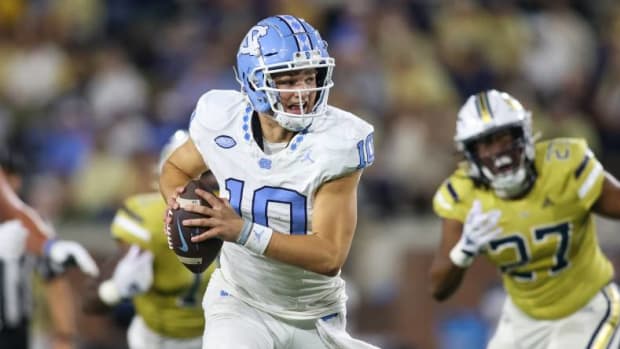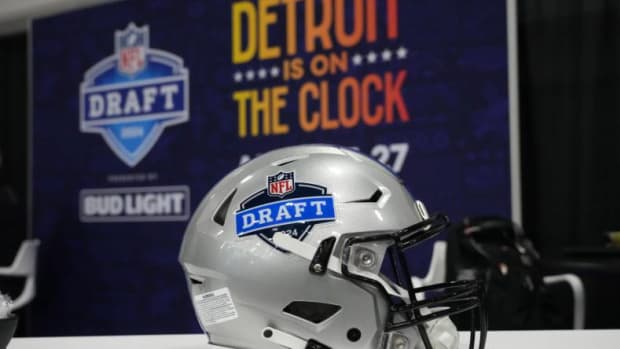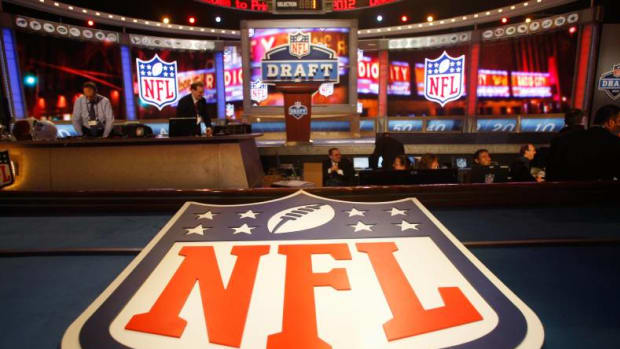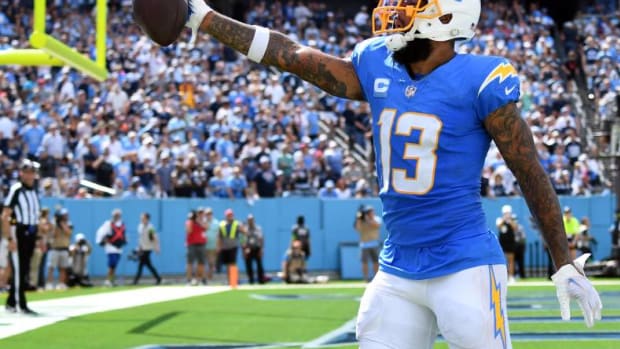Leinweber’s Top 7 Tight Ends in the 2021 NFL Draft
Coming into the 2020 college season, the potential tight-end class had a lot of hype, much of which was warranted. With multiple talented players opting to return to school for another season, it has lost plenty of depth and made it a rather thin class overall. There is however top-end talent and a couple of mid-round options that will stick on rosters and contribute. Tight end may be the ultimate mismatch position at the next level and having a great one gives opposing defensive coordinators sleepless nights.
7. Tony Poljan, Virginia
After converting from quarterback and transferring to Virginia, the former Central Michigan tight end showed he could be productive at the power-5 level racking up 411 yards and six touchdowns for the Cavaliers. Displaying tremendous size, Poljan has a big catch radius, allowing him to make plays with the ball in the air in the red zone. As a receiver, he is still inconsistent, suffering from frustrating drops. Poljan is a capable blocker in the rushing and receiving game, showing physicality and active feet. While he can change directions, he is not a separator as he is slow in a straight line. Much of his production came sitting underneath against zone defenses. Poljan projects as a depth tight end who can play in-line and block when the offense deploys heavy personnel. His hands are not strong enough to be given many targets at this point. In the right situation, Poljan could develop into the second tight end on a depth chart.
Value: 7th Round
6. Tre’ McKitty, Georgia
A two-year starter at Florida State, McKitty transferred to Georgia but got lost on the Dawgs depth chart. He is strong in-line, creating movement up front when taking on smaller defenders or those that have similar size. McKitty has big and strong hands to haul in passes reliably. When they are off target, he can adjust and catch outside his frame. While he has some wiggle at the top of his routes, he lacks the explosiveness to separate and does not carry much speed through his breaks. After the catch, he picks up extra yardage and has an active off-hand. McKitty is an average athlete who can not stress defenses vertically or use his speed in the open field. Projecting as a backup tight end, he can be a good one with reliable hands and in-line blocking ability. McKitty’s physicality should allow him to contribute on special teams.
Value: 6th Round
5. Brevin Jordan, Miami
The former four-star recruit has contributed to Miami’s offense since he was a true freshman. Jordan has a strong frame despite being on the shorter side for tight ends. He is dangerous with the ball in his hands as he is difficult to tackle due to his physicality. Jordan is a long strider with some explosiveness, but average speed. As a blocker, he has the condensed body type that can be molded, but currently lacks technique, unable to stay attached and lunging causes him to whiff. He is better in pass protection as he does not have to be a proactive blocker. Jordan struggles to separate with his routes lacking suddenness and effort, and many of them are run at half speed. He possesses unreliable hands, dropping many footballs; the ones he does catch are often body catches. This prevents him from making plays in traffic. Jordan projects as a developmental tight end who is far away from being a starter, but has some traits in the form of his physicality and athleticism to improve upon. He will have to contribute on special teams to stick as a third tight end or he could be relegated to the practice squad. His immediate impact might be as a weapon on screens to take advantage of his run after the catch ability. If he stays as unreliable at catching the ball, he could find himself quickly falling out of favor with coaches and quarterbacks.
Value: 5th Round
4. Hunter Long, Boston College
A three-year contributor with great measurements at the position, Long has the size that NFL teams covet. He has soft and natural hands to catch the ball reliably and secure it through traffic. At times he is too patient attacking the football and he is not explosive vertically, catching high passes because of his length. Using leverage to create separation, Long understands how to seal off defenders and make himself available to the passer. He does not gain separation with his route running and while he is smooth, his lack of dynamism prevents him from running away from defenders. After the catch, he is active and shows clear open-field vision. Long is not physical enough to run through defenders or break tackles when getting wrapped up. He is better as a passive blocker when sealing off the edge or pass protecting as he is unable to drive defenders off the ball. Long projects as a low-end starting tight end in the league who would be a strong backup. His frame promises untapped potential as a run blocker. As a receiver, he is limited due to his average athleticism despite having great hands.
Value: 3rd/4th Round
3. Tommy Tremble, Notre Dame
While the stats might not tell it, Tremble is a talented tight end who Notre Dame was never able to maximize during his two seasons in South Bend. The Georgia native recorded just 35 catches for 401 yards, but he was a vital part of the successful running game for the Irish. The competitive run blocker is successful on the move and has some nasty to him, finishing blocks with defenders on the ground. He is smart in pass protection, recognizing blitzes from the second level and absorbing contact before anchoring. Tremble is light on his feet in the open field, getting in and out of his breaks to gain separation. Possessing sufficient speed, he is better suited in condensed spaces and displays quick agility. He can catch the ball when he is open and when a defender is all over him, but does not make catches at the high point. After the catch, he uses his athleticism to defeat pursuit angles. Using physicality and leverage, he can create small windows at the top of his routes. Tremble projects as a blocking tight end with untapped potential as a receiver, especially between the 20s. He would fit into a wide zone that utilizes tight ends on split zone play-actions, taking advantage of his blocking and athleticism.
Value: 3rd/4th Round
2. Pat Freiermuth, Penn State
A three-year starter at tight end, Freiermuth was productive racking up 1,185 yards and 16 touchdowns. The Nittany Lions deployed him all over the field; he plays in-line or flexed out all the way to the sideline. Freiermuth has a loose lower body, allowing him to make tight turns or carry speed through wider ones. This makes him a strong separator who is sudden and can get open against man coverage. His hands are generally strong and reliable over the middle. At times, he can have frustrating drops and he is not a ball-winner on off-target passes. After the catch, Freiermuth is active and physical, keeping his legs churning and lowering his shoulder. He can dish out a mean stiff-arm with his off hand. Freiermuth flashes the ability to use his leverage and frame to create separation and has the movement skills to do it consistently if taught. He is a strong proactive blocker against smaller defenders as he is able to latch on and wrestle them to the ground with his leg drive. In pass protection and passive situations, he struggles to absorb and sustain. Athleticism in a straight line is sufficient. Freiermuth projects as a future starting tight end who has the frame and movement skills to be successful. Like most prospects at the position, he has to improve the technical aspects of his game. Freiermuth will be a consistent separator who adds value in-line as a run blocker.
Value: 2nd/3rd Round
1. Kyle Pitts, Florida
One of the most dominant tight ends to ever play college football, Pitts is a special separator at his size. He is sudden and flexible. Combining that with his understanding of attacking man coverage and he is almost impossible to guard one-on-one. At 6-foot-6, 245 pounds, he looks like a wide receiver running his routes. Pitts is a dominant ball-winner at the catch point, tracking the ball well and being able to get higher than any defenders. He has soft hands to be reliable on levels. When flexed out, the Pennsylvania native can adjust to back-shoulder passes. His physicality has improved every year as he has filled out his frame. Pitts uses his length as a blocker and is solid in this area. At the top of his routes, he pushes off slightly and keeps his frame clean while running routes. He is light on his feet and extremely loose leading to easy movement. On vertical routes, he has sufficient speed to put stress on defenses. Pitts projects as an offensive weapon who can be lined up all over the formation. He can beat cornerbacks one-on-one and is a good enough blocker to not be a liability in-line. His versatility makes him the ultimate mismatch that defensive coaches will spend sleepless nights trying to figure out how to slow him down. Pitts will be one of the best tight ends in the league Week 1 of the 2021 season.
Value: Top 10
QB | RB | FB | WR | iWR | TE | LT | RT | OG | OC | DT | NG | 3-4 DE | 4-3 DE | 3-4 OLB | 4-3 OLB | ILB | CB | iCB | FS | SS




